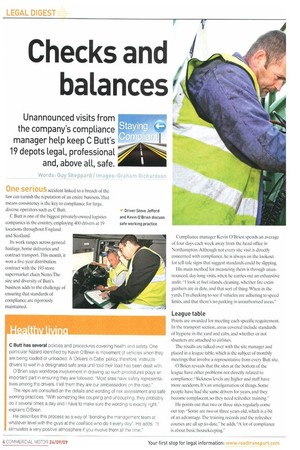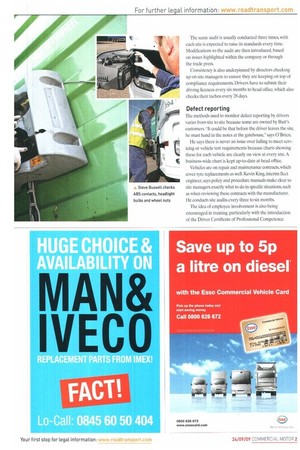Checks and balances
Page 26

Page 27

If you've noticed an error in this article please click here to report it so we can fix it.
Unannounced visits from the company's compliance manager help keep C Butt's 19 depots legal, professional and, above all, safe.
Words: Guy Sheppard / images: Graham Richardson 'IOUS accident linked to a breach of the law can tarnish the reputation of an entire business That means consistency is the key to compliance for large, diverse operators such as C Butt. Driver Steve Jefford C Butt is one of the biggest privately-owned logistics and Kevin O'Brien discuss companies in the country, employing 400 drivers at 19 safe working practice
locations throughout England and Scotland.
Its work ranges ticioss general haulage, home deliveries and contract transport. This month, it won a live-year distribution contract with the 193-store supermarket chain Netto.The size and diversity of Butt's business adds to the challenge of ensuring that standards of compliance are rigorously maintained. Compliance manager Kevin O'Brien spends an average of four days each week away from the head office in Northampton. Although not every site visit is directly concerned with compliance, he is always on the lookout for tell-tale signs that suggest standards could be slipping.
His main method for measuring them is through unannounced, day-long visits, when he carries out an exhaustive audit. "I look at fuel islands, cleaning, whether fire extinguishers are in date, and that sort of thing. When in the yards. I'm checking to see if vehicles are adhering to speed limits, and that there's no parking in unauthorised areas"
League table PULMS are awarded for meeting each specific requirement. In the transport section, areas covered include standards of hygiene in the yard and cabs, and whether or not shunters are attached to airlines
The results are talked over with the site manager and placed in a league table, which is the subject of monthly meetings that involve a representative from every Butt site.
O'Brien reveals that the sites at the bottom of the league have other problems not directly related to compliance: "Sickness levels are higher and staff have more accidents. It's an amalgamation of things. Some people have had the same drivers for years, and they become complacent, so they need refresher training."
He points out that two or three sites regularly come out top. -Some are two or three years old, which is a bit of an advantage. The training records and the refresher courses are all up-to-date," he adds."A lot of compliance is about basic housekeeping." The same audit is usually conducted three times, with each site is expected to raise its standards every time. Modifications to the audit are then introduced, based on issues highlighted within the company or through the trade press.
Consistency is also underpinned by directors checking up on site managers to ensure they are keeping on top of compliance requirements. Drivers have to submit their driving licences every six months to head office, which also checks their tachos every 28 days.
Defect reporting Ihe methods used to monitor defect reporting by drivers varies from site to site because some are owned by Butt's customers. It could be that before the driver leaves the site, he must hand in the notes at the gatehouse," says O'Brien.
He says there is never an issue over failing to meet servicing or vehicle test requirements because charts showing these for each vehicle are clearly on view at every site. A business-wide chart is kept up-to-date at head office.
Vehicles are on repair and maintenance contracts, which cover tyre replacements as well. Kevin King, interim fleet engineer, says policy and procedure manuals make clear to site managers exactly what to do in specific situations, such as when reviewing these contracts with the manufacturer. He conducts site audits every three to six months.
The idea of employee involvement is also being encouraged in training, particularly with the introduction of the Driver Certificate of Professional Competence












































































































































